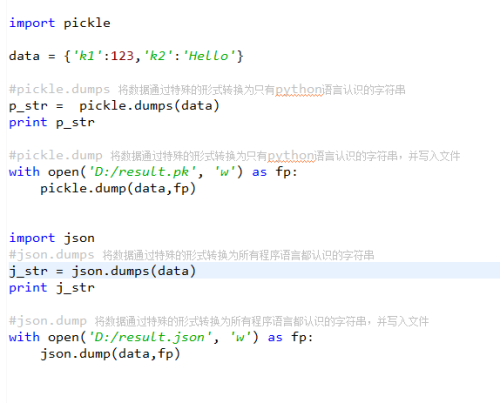python模块part3
发布时间:2019-09-26 07:28:38编辑:auto阅读(2556)
time和datetime(http://www.jb51.net/article/49326.htm)
json,用于字符串 和 python数据类型间进行转换
pickle,用于python特有的类型 和 python的数据类型间进行转换
一:内建模块
在Python中,通常有这几种方式来表示时间:1)时间戳 2)格式化的时间字符串 3)元组(struct_time)共九个元素。由于Python的time模块实现主要调用C库,所以各个平台可能有所不同。
UTC(Coordinated Universal Time,世界协调时)亦即格林威治天文时间,世界标准时间。在中国为UTC+8。DST(Daylight Saving Time)即夏令时。
时间戳(timestamp)的方式:通常来说,时间戳表示的是从1970年1月1日00:00:00开始按秒计算的偏移量。我们运行“type(time.time())”,返回的是float类型。返回时间戳方式的函数主要有time(),clock()等。
元组(struct_time)方式:struct_time元组共有9个元素,返回struct_time的函数主要有gmtime(),localtime(),strptime()。下面列出这种方式元组中的几个元素:
#_*_coding:utf-8_*_
import time
# print(time.clock()) #返回处理器时间,3.3开始已废弃 , 改成了time.process_time()测量处理器运算时间,不包括sleep时间,不稳定,mac上测不出来
# print(time.altzone) #返回与utc时间的时间差,以秒计算\
# print(time.asctime()) #返回时间格式"Fri Aug 19 11:14:16 2016",
# print(time.localtime()) #返回本地时间 的struct time对象格式
# print(time.gmtime(time.time()-800000)) #返回utc时间的struc时间对象格式
# print(time.asctime(time.localtime())) #返回时间格式"Fri Aug 19 11:14:16 2016",
#print(time.ctime()) #返回Fri Aug 19 12:38:29 2016 格式, 同上
# 日期字符串 转成 时间戳
# string_2_struct = time.strptime("2016/05/22","%Y/%m/%d") #将 日期字符串 转成 struct时间对象格式
# print(string_2_struct)
# #
# struct_2_stamp = time.mktime(string_2_struct) #将struct时间对象转成时间戳
# print(struct_2_stamp)
#将时间戳转为字符串格式
# print(time.gmtime(time.time()-86640)) #将utc时间戳转换成struct_time格式
# print(time.strftime("%Y-%m-%d %H:%M:%S",time.gmtime()) ) #将utc struct_time格式转成指定的字符串格式
#时间加减
import datetime
# print(datetime.datetime.now()) #返回 2016-08-19 12:47:03.941925
#print(datetime.date.fromtimestamp(time.time()) ) # 时间戳直接转成日期格式 2016-08-19
# print(datetime.datetime.now() )
# print(datetime.datetime.now() + datetime.timedelta(3)) #当前时间+3天
# print(datetime.datetime.now() + datetime.timedelta(-3)) #当前时间-3天
# print(datetime.datetime.now() + datetime.timedelta(hours=3)) #当前时间+3小时
# print(datetime.datetime.now() + datetime.timedelta(minutes=30)) #当前时间+30分
#
# c_time = datetime.datetime.now()
# print(c_time.replace(minute=3,hour=2)) #时间替换格式参照
%a 本地(locale)简化星期名称 %A 本地完整星期名称 %b 本地简化月份名称 %B 本地完整月份名称 %c 本地相应的日期和时间表示 %d 一个月中的第几天(01 - 31) %H 一天中的第几个小时(24小时制,00 - 23) %I 第几个小时(12小时制,01 - 12) %j 一年中的第几天(001 - 366) %m 月份(01 - 12) %M 分钟数(00 - 59) %p 本地am或者pm的相应符 一 %S 秒(01 - 61) 二 %U 一年中的星期数。(00 - 53星期天是一个星期的开始。)第一个星期天之前的所有天数都放在第0周。 三 %w 一个星期中的第几天(0 - 6,0是星期天) 三 %W 和%U基本相同,不同的是%W以星期一为一个星期的开始。 %x 本地相应日期 %X 本地相应时间 %y 去掉世纪的年份(00 - 99) %Y 完整的年份 %Z 时区的名字(如果不存在为空字符) %% ‘%’字符
时间关系转换
更多点击这里
2.random模块
#!/usr/bin/env python
#_*_encoding: utf-8_*_
import random
print (random.random()) #0.6445010863311293
#random.random()用于生成一个0到1的随机符点数: 0 <= n < 1.0
print (random.randint(1,7)) #4
#random.randint()的函数原型为:random.randint(a, b),用于生成一个指定范围内的整数。
# 其中参数a是下限,参数b是上限,生成的随机数n: a <= n <= b
print (random.randrange(1,10)) #5
#random.randrange的函数原型为:random.randrange([start], stop[, step]),
# 从指定范围内,按指定基数递增的集合中 获取一个随机数。如:random.randrange(10, 100, 2),
# 结果相当于从[10, 12, 14, 16, ... 96, 98]序列中获取一个随机数。
# random.randrange(10, 100, 2)在结果上与 random.choice(range(10, 100, 2) 等效。
print(random.choice('liukuni')) #i
#random.choice从序列中获取一个随机元素。
# 其函数原型为:random.choice(sequence)。参数sequence表示一个有序类型。
# 这里要说明一下:sequence在python不是一种特定的类型,而是泛指一系列的类型。
# list, tuple, 字符串都属于sequence。有关sequence可以查看python手册数据模型这一章。
# 下面是使用choice的一些例子:
print(random.choice("学习Python"))#学
print(random.choice(["JGood","is","a","handsome","boy"])) #List
print(random.choice(("Tuple","List","Dict"))) #List
print(random.sample([1,2,3,4,5],3)) #[1, 2, 5]
#random.sample的函数原型为:random.sample(sequence, k),从指定序列中随机获取指定长度的片断。sample函数不会修改原有序列。实际应用:
#!/usr/bin/env python
# encoding: utf-8
import random
import string
#随机整数:
print( random.randint(0,99)) #70
#随机选取0到100间的偶数:
print(random.randrange(0, 101, 2)) #4
#随机浮点数:
print( random.random()) #0.2746445568079129
print(random.uniform(1, 10)) #9.887001463194844
#随机字符:
print(random.choice('abcdefg&#%^*f')) #f
#多个字符中选取特定数量的字符:
print(random.sample('abcdefghij',3)) #['f', 'h', 'd']
#随机选取字符串:
print( random.choice ( ['apple', 'pear', 'peach', 'orange', 'lemon'] )) #apple
#洗牌#
items = [1,2,3,4,5,6,7]
print(items) #[1, 2, 3, 4, 5, 6, 7]
random.shuffle(items)
print(items) #[1, 4, 7, 2, 5, 3, 6]生成随机验证码:
import random checkcode = '' for i in range(4): current = random.randrange(0,4) if current != i: temp = chr(random.randint(65,90)) else: temp = random.randint(0,9) checkcode += str(temp) print (checkcode)
3.os模块
提供对操作系统进行调用的接口
os.getcwd() 获取当前工作目录,即当前python脚本工作的目录路径
os.chdir("dirname") 改变当前脚本工作目录;相当于shell下cd
os.curdir 返回当前目录: ('.')
os.pardir 获取当前目录的父目录字符串名:('..')
os.makedirs('dirname1/dirname2') 可生成多层递归目录
os.removedirs('dirname1') 若目录为空,则删除,并递归到上一级目录,如若也为空,则删除,依此类推
os.mkdir('dirname') 生成单级目录;相当于shell中mkdir dirname
os.rmdir('dirname') 删除单级空目录,若目录不为空则无法删除,报错;相当于shell中rmdir dirname
os.listdir('dirname') 列出指定目录下的所有文件和子目录,包括隐藏文件,并以列表方式打印
os.remove() 删除一个文件
os.rename("oldname","newname") 重命名文件/目录
os.stat('path/filename') 获取文件/目录信息
os.sep 输出操作系统特定的路径分隔符,win下为"\\",Linux下为"/"
os.linesep 输出当前平台使用的行终止符,win下为"\t\n",Linux下为"\n"
os.pathsep 输出用于分割文件路径的字符串
os.name 输出字符串指示当前使用平台。win->'nt'; Linux->'posix'
os.system("bash command") 运行shell命令,直接显示
os.environ 获取系统环境变量
os.path.abspath(path) 返回path规范化的绝对路径
os.path.split(path) 将path分割成目录和文件名二元组返回
os.path.dirname(path) 返回path的目录。其实就是os.path.split(path)的第一个元素
os.path.basename(path) 返回path最后的文件名。如何path以/或\结尾,那么就会返回空值。即os.path.split(path)的第二个元素
os.path.exists(path) 如果path存在,返回True;如果path不存在,返回False
os.path.isabs(path) 如果path是绝对路径,返回True
os.path.isfile(path) 如果path是一个存在的文件,返回True。否则返回False
os.path.isdir(path) 如果path是一个存在的目录,则返回True。否则返回False
os.path.join(path1[, path2[, ...]]) 将多个路径组合后返回,第一个绝对路径之前的参数将被忽略
os.path.getatime(path) 返回path所指向的文件或者目录的最后存取时间
os.path.getmtime(path) 返回path所指向的文件或者目录的最后修改时间更多点击这里
4.sys模块
sys.argv 命令行参数List,第一个元素是程序本身路径
sys.exit(n) 退出程序,正常退出时exit(0)
sys.version 获取Python解释程序的版本信息
sys.maxint 最大的Int值
sys.path 返回模块的搜索路径,初始化时使用PYTHONPATH环境变量的值
sys.platform 返回操作系统平台名称
sys.stdout.write('please:')
val = sys.stdin.readline()[:-1]5.shutil模块
参考http://www.cnblogs.com/wupeiqi/articles/4963027.html
6.json和pickle模块
用于序列化的两个模块
Json模块提供了四个功能:dumps、dump、loads、load
pickle模块提供了四个功能:dumps、dump、loads、load
7. shelve模块
shelve模块是一个简单的k,v将内存数据通过文件持久化的模块,可以持久化任何pickle可支持的python数据格式
import shelve
d = shelve.open('shelve_test') #打开一个文件
class Test(object):
def __init__(self,n):
self.n = n
t = Test(123)
t2 = Test(123334)
name = ["alex","rain","test"]
d["test"] = name #持久化列表
d["t1"] = t #持久化类
d["t2"] = t2
d.close()
上一篇: centos7中python3环境支持s
下一篇: python3 发送电子邮件
- openvpn linux客户端使用
51746
- H3C基本命令大全
51426
- openvpn windows客户端使用
41838
- H3C IRF原理及 配置
38611
- Python exit()函数
33104
- openvpn mac客户端使用
30096
- python全系列官方中文文档
28766
- python 获取网卡实时流量
23763
- 1.常用turtle功能函数
23679
- python 获取Linux和Windows硬件信息
22045
- Ubuntu本地部署dots.ocr
75°
- Python搭建一个RAG系统(分片/检索/召回/重排序/生成)
2272°
- Browser-use:智能浏览器自动化(Web-Agent)
2967°
- 使用 LangChain 实现本地 Agent
2470°
- 使用 LangChain 构建本地 RAG 应用
2415°
- 使用LLaMA-Factory微调大模型的function calling能力
3012°
- 复现一个简单Agent系统
2423°
- LLaMA Factory-Lora微调实现声控语音多轮问答对话-1
3228°
- LLaMA Factory微调后的模型合并导出和部署-4
5321°
- LLaMA Factory微调模型的各种参数怎么设置-3
5144°
- 姓名:Run
- 职业:谜
- 邮箱:383697894@qq.com
- 定位:上海 · 松江


